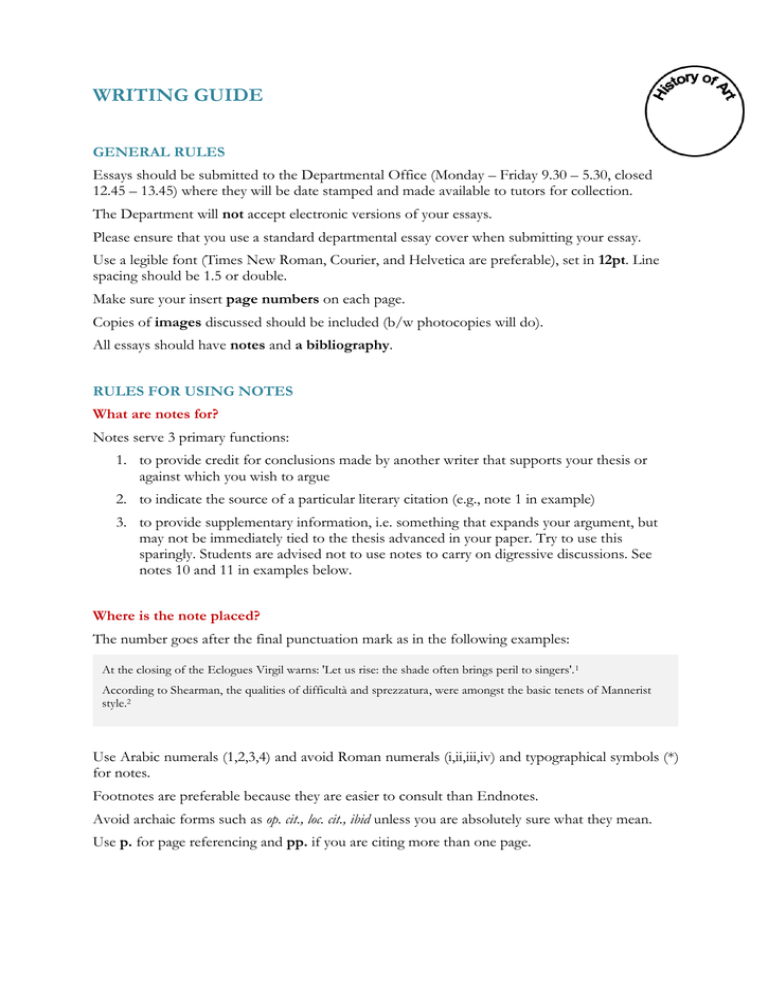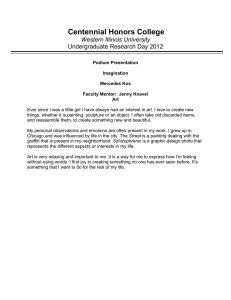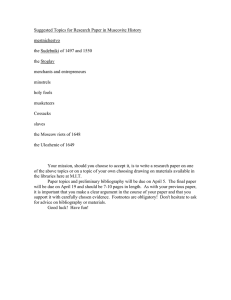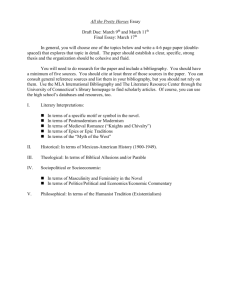WRITING GUIDE
advertisement

WRITING GUIDE GENERAL RULES Essays should be submitted to the Departmental Office (Monday – Friday 9.30 – 5.30, closed 12.45 – 13.45) where they will be date stamped and made available to tutors for collection. The Department will not accept electronic versions of your essays. Please ensure that you use a standard departmental essay cover when submitting your essay. Use a legible font (Times New Roman, Courier, and Helvetica are preferable), set in 12pt. Line spacing should be 1.5 or double. Make sure your insert page numbers on each page. Copies of images discussed should be included (b/w photocopies will do). All essays should have notes and a bibliography. RULES FOR USING NOTES What are notes for? Notes serve 3 primary functions: 1. to provide credit for conclusions made by another writer that supports your thesis or against which you wish to argue 2. to indicate the source of a particular literary citation (e.g., note 1 in example) 3. to provide supplementary information, i.e. something that expands your argument, but may not be immediately tied to the thesis advanced in your paper. Try to use this sparingly. Students are advised not to use notes to carry on digressive discussions. See notes 10 and 11 in examples below. Where is the note placed? The number goes after the final punctuation mark as in the following examples: At the closing of the Eclogues Virgil warns: 'Let us rise: the shade often brings peril to singers'. 1 According to Shearman, the qualities of difficultà and sprezzatura, were amongst the basic tenets of Mannerist style.2 Use Arabic numerals (1,2,3,4) and avoid Roman numerals (i,ii,iii,iv) and typographical symbols (*) for notes. Footnotes are preferable because they are easier to consult than Endnotes. Avoid archaic forms such as op. cit., loc. cit., ibid unless you are absolutely sure what they mean. Use p. for page referencing and pp. if you are citing more than one page. What does not need to be noted? General knowledge (obvious or general historical facts) does not need to be noted as in the following examples: In Parmigianino's painting the Madonna del Collo Lungo the neck of the Madonna and the body of the Christ child are abnormally elongated . The Palazzo Vendramin-Calergi was originally owned by the Loredan family. The Black Death killed one third of the population in Europe. The Pompeii was not excavated until the eighteenth century What needs to be noted? Direct quotations: Quotes within a sentence should be punctuated as in the example: At the closing of the Eclogues Virgil warns: 'Let us rise: the shade often brings peril to singers'. 1 If you cite more than four lines, the passage should be indented as a single-spaced block. This is known as a "block-quote" and should be properly introduced in your text: Alberti comments on the rhetorical function of naturalism in sacred painting: We should also consider it a very great gift to men that painting has represented the gods they worship, for painting has contributed considerably to the piety which binds us to the gods, filling our minds with sound beliefs.3 Do not change the font size or appearance of the block quote; i.e., you should not suddenly switch to a smaller font or a different font and you should not use italics. Do not pad your essay with endless block quotes that could be paraphrased in your own words! This is lazy and sloppy scholarship. Remember: the point of a quotation or paraphrased passage is to illustrate a point made by another author that you are using to push your own argument along (as evidence, as a point of contention, as a means of refining your own ideas, etc.). Paraphrasing Paraphrasing means that you have taken an author's ideas or opinions and explained them in your own words; it does not mean that you have merely changed some of the words. In all cases, the sources for paraphrases and summaries must be noted. How to write proper paraphrases - examples: PLAGIARISM (no credit given, passage more or less copied directly from the Cropper and Dempsey book): Raphael understood how the story might be improved by associating it with classical images of the capture of a city, for instance, or by combining representations of battles taken from pagan antiquity with the details of the Gospel story. BAD PARAPHRASE (credit given, but passage more or less copied verbatim): Raphael understood how the story might be enhanced, for example by associating it with classical pictures of the taking of a town, or by combining representations of battles taken from antiquity with information from the Bible story.4 BAD PARAPHRASE (credit given, but passage more or less copied verbatim): Raphael understood how the story might be enhanced, for example by associating it with classical pictures of the taking of a town, or by combining representations of battles taken from antiquity with information from the Bible story.4 PROPER PARAPHRASE (main points articulated in your own words and credit given in note): It has been argued that, in an attempt to improve the visual effects of the narrative, Raphael used classical images of the capture of a city and combined these images with written descriptions of battles taken from pagan and Christian texts If you are quoting a source (e.g., something that the Renaissance author Torquato Tasso is supposed to have said) that is itself quoted in another source (e.g., John Shearman's book Mannerism), be sure to write this in your note: 9 Tasso quoted in Shearman, p. 139 Using Proper Style When Writing Notes As a general rule, the footnote should include the author's last name and page number. Primary and secondary sources follow different rules, but when in doubt, use the above rule. Although it is better to 'over-note', you should not go overboard: a 2500-word research paper, on average, might have between 10 - 25 notes. There are several different methods for referencing. For a complete and an authoritative guide see the MHRA Style Guide. A Handbook for Authors and Editors, 3rd edition, London: Modern Humanities Research Association, 2013. * Students: please read chapter 11 very carefully. NOTE: footnotes are included in your word-count. BIBLIOGRAPHY Using Proper Style When Writing a Bibliography Particular formats for bibliographic entries vary. The most commonly accepted and universally understood format is outlined in detail in the MHRA Style Guide Include in the bibliography itself: 1. Only those articles and / or books that you have cited. Do not inflate your bibliography with titles that you haven't actually referenced! As with the overuse of block quotes, this looks lazy, sloppy, and unprofessional. 2. Websites such as Wikipedia, while useful references, are not acceptable as research sources. If you do use a legitimate website as a source, make sure to include the name of the author (if there is one), the title of the page, the complete URL (this is the web address and begins with http:// or https://), and the date that you accessed it. While many journals exist in both print and electronic form (accessible through sites such as JSTOR, Muse, etc.), there are also some journals which exist solely online such as Senses of Cinema without a print version. They will usually be identified by a Volume, Number, and Year like traditional print journals. These are acceptable online or 'electronic' sources. When in doubt, ask your lecturer for advice! The most important rule is to be consistent! Bibliography Examples Article in an exh. cat. (= exhibition catalogue) by several different writers; do not forget to include the name(s) of editor(s) if this is known Ackerman, J.S. ‘The Regions of Italian Renaissance Architecture,’ in The Renaissance from Brunelleschi to Michelangelo. The Representation of Architecture, eds. H.A. Millon and V. Magnago Lampugnani, pp. 319347. (exh. cat., Palazzo Grassi). Milan, 1994. Primary source with several translators (trans. = translator) Alberti, L.B. On the Art of Building in Ten Books, trans. J. Rykwert, N. Leach, and R. Tavernor. Cambridge, 1996. Primary source translated and edited by one author (ed. = editor; eds. = editors) Alberti, L.B. On Painting and On Sculpture, ed. and trans. C. Grayson. London, 1972. study by two authors Cropper, E. and Dempsey, C. Nicolas Poussin. Friendship and the Love of Painting. Princeton, 1996. Facsimile text without editors (rpt. = reprinted); note (1) French capitalization: copy your source carefull, because they do not capitalize words in titles as much as any other nation. de Vigenère, B. Les images ou tableaux de platte peinture des deux Philostrates Sophistes grecs. Paris, 1614 (rpt. New York, 1976). Website (include the full URL as well as the date that you accessed the page) Loh, M. Writing Guide, http://www.ucl.ac.uk/art-history/students/current_students/writing_guide (accessed: 16 November 2008). Article in a periodical (note that the page numbers are placed at the end; ‘5’ = volume number) McTighe, S. ‘Nicolas Poussin's Representations of Storms and Libertinage in the Mid-SeventeenthCentury’ in Word and Image 5 (1989): pp. 333-361. Article in a book of collected essays by the same author (Panofsky). Panofsky, E. ‘Et in Arcadia Ego: Poussin and the Elegiac Tradition,’ in Meaning in the Visual Arts, ed. E. Panofsky, pp. 295-320. Garden City, 1955a. Entry for a book (note in the use of a/b in the two entries for Panofsky: a/b differentiates between two texts written by the same author in the same year) Panofsky, E. The Life and Art of Albrecht Dürer. Princeton, 1955b. Rosenberg, P. France in the Golden Age: Seventeenth-Century French Paintings in American Collections (exh. cat., Book with one author Shearman, J. Mannerism. Harmondsworth, 1986. Modern edition with several volumes of primary source in original language Vasari, G. Le vite de' più eccellenti pittori, scultori ed architetti moderni, ed. G. Milanesi, 9 vols. Florence, 1906. Ancient texts in translation (make sure to include the name of the translator) Virgil. Eclogues, Georgics, Aeneid I-VI, trans. H.R. Faircloug. Cambridge, 1986. An article in a book of collected essays with multiple authors (make sure to include the name of the editor/editors) Weil-Garris, K. ‘Bandinelli and Michelangelo: A Problem of Artistic Identity,’ in Art the Ape of Nature: Studies in Honor of H.W. Janson, eds. M. Barasch and L. Freedman Sandler, pp. 223-251. New York, 1981. ILLUSTRATIONS Basic Rules Include the following when using illustrations: 1. Artist (if known) 2. Title of work 3. Date (if none is given, indicate at least the century in which it was produced) 4. Location (church, museum, private collection, etc.) 5. Medium 6. Dimensions 7. Source (from where you've taken the image; NOTE: these texts should also be listed in your general bibliography) Most texts follow this format more or less. Try to be as inclusive and consistent as possible. Illustrations: Examples Fresco Giotto. Last Judgment, ca. 1305. Arena Chapel, Padua. Fresco. (Source: Hartt) Veronese. Abundance, Fortitude, and Envy, ca. 1561. Villa Barbaro, Maser. Fresco (ceiling). (Source: Hartt) Painting Raphael. Baldassare Castiglione, ca. 1515. Louvre, Paris. Canvas. 32 ½” x 26 ½”. (Source: Hartt) If the painting is known by more than one name, put the other title in parentheses. Giorgione. Nativity and Adoration of the Shepherds (Allendale Nativity), ca. 1505(?). National Gallery of Art, Washington DC. Panel. 35 ¾” x 43 ½”. (Source: Hartt) Dante Gabriel Rossetti. Ecce Ancilla Domini! (The Annunciation), 1850. Tate Gallery, London. Canvas mounted on wood, 28 ½” x 16 ½”. (Source: Rosenblum and Janson) Painting (in situ) Tintoretto. Last Supper, 1577-81. Sala Grande, Scuola di S. Rocco, Venice. Canvas. H. 17’9”. (Source: Hartt) Altarpiece Titian. Assumption of the Virgin, 1516-18. Sta. Maria Gloriosa dei Frari, Venice. Panel. 22’6” x 11’10”. (Source: Hartt) Sculpture Laocoön, first century AD. Cortile Belvedere, Vatican Museums. Marble. H. 2.42 m. (Source: Boucher) Auguste Rodin. Honoré de Balzac, 1891-98. Musée Rodin, Paris. Plaster. H. 9’10”. (Source: Rosenblum and Janson) Robert Rauschenberg. Bed, 1955. Collection of Mr. and Mrs. Leo Castelli, New York. Mixed media. 6’2” x 2’7”. (Source: Hunter and Jacobus) Sculpture (in situ) If the work is in its original location (e.g., the Cornaro Chapel, Sta. Maria della Vittoria, Rome) this information should also be included. Gianlorenzo Bernini. Ecstasy of Saint Teresa, 1647-52. Cornaro Chapel, Sta. Maria della Vittoria, Rome. Marble. (Source: Boucher) Antonio Canova. Tomb of the Archduchess Maria Christina, 1798-1805. Church of the Augustinians, Vienna. Marble. (Source: Rosenblum and Janson) Richard Serra. Tilted Arc, 1981. Federal Plaza, New York. Hot-rolled steel. 120’ long. (Source: Hunter and Jacobus). Drawing (Preparatory Study) Nicolas Poussin. Study for 'The Holy Family on the Steps', ca. 1648. Pierpont Morgan Library (III.7) Pen, ink, wash, and chalk. 7 ¼” x 9 15/16”. (Source: Goldfaber) Drawing Leonardo da Vinci. Deluge, ca. 1514-19. Royal Library, Windsor. Black chalk. 6 ¼” x 8 ¼”. (Source: Hartt) Engraving Domenico Campagnola. Venus Reclining in a Landscape, 1517. Rosenwald Collection, National Gallery of Art, Washington DC. Engraving. 3 ¾” x 5 ¼” (Source: Russell and Barnes) Print after Original Marcantonio Raimondi (after Raphael). Death of Lucretia, ca. 1511-12. Harvey D. Parker Collection, Museum of Fine Arts, Boston. Engraving. 8 ½” x 5 ¼”. (Source: Russell and Barnes) Architectural Drawings Baldassare Peruzzi. Perspective Study, with Section and Plan, of St. Peter’s, ca. 1505. Gabinetto dei Disegni e Stampe, Uffizi, Florence. Pen and ink and pencil. (Source: Hartt) Buildings Note: architectural structures are usually not italicized or underlined Donato Bramante. Tempietto, S. Pietro in Montorio, Rome. 1502-11. H. 47’. (Source: Hartt) Henri Labrouste. Reading Room, Bibliothèque Nationale, Paris. 1862-68. (Source: Hunter and Jacobus) Bibliography to this section: (Normally these texts would be included in your general bibliography) Boucher, B. Italian Baroque Sculpture. London, 1998. Goldfarb, H.T. From Fontainbleau to the Louvre. French Drawing from the 17th Century (exh. cat., Cleveland Museum of Art). Bloomington, 1989. Hartt, F. History of Italian Renaissance Art. Painting, Sculpture, Architecture (4th edition). New York, 1994. Hunter, S. and J. Jacobus. Modern Art (2nd edition). New York, 1985. Rosenblum, B and H.W. Janson. Nineteenth-Century Art. New York, 1984. Russell, H.D. and Barnes, B. Eva/Ave. Women in Renaissance and Baroque Prints (exh. cat., National Gallery of Art, Washington DC). New York, 1990. CHECKLIST Before submitting an essay, make sure you: 1. Spellcheck!!! 2. Proofread for any other mistakes. Most common errors: it's/its; there/their; from/form; were/we're/where; etc. 3. Put your name on the cover page 4. Put the name of the course and lecturer on the cover page





